#German Egyptologists
Note
Funniest part about the gospel of Jesus’ wife is how big of a scam it is
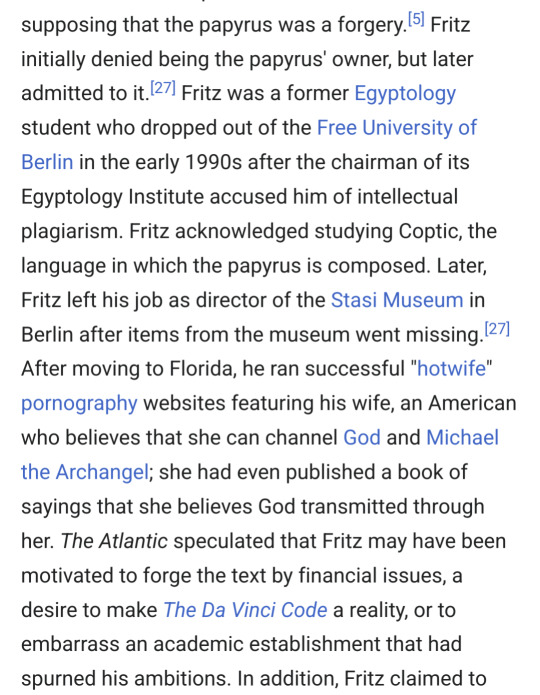
You're laughing. A German egyptologist and his prophet mystic wife who makes cuck porn fabricated biblical apocrypha based on a Dan Brown novel, and you're laughing.
5K notes
·
View notes
Text
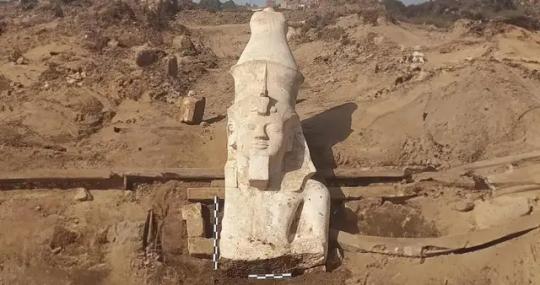
The Long-Lost Top Half of an Enormous Ramses II Statue Found
A German researcher found the lower section of the Egyptian pharaoh’s likeness nearly 100 years ago.
Archaeologists in Egypt have uncovered the upper half of a towering statue of Ramses II, cracking a century-long mystery. Found in the ancient city of Hermopolis (now Ashmunein), the 12.5-foot-tall limestone fragment lines up perfectly with the lower section of a sculpture discovered nearby in 1930.
The ancient statue depicts Ramses in a seated position, adorned with a crown and a headdress topped with a cobra, according to a statement from the Egyptian Ministry of Tourism and Antiquities. The dual crown indicates Ramses’ simultaneous authority over the kingdoms of Upper and Lower Egypt, while the cobra represents royalty, writes the National’s Kamal Tabikha.
The upper area of the back column of the statue is etched with hieroglyphs that list Ramses’ many titles, glorifying the king as “one of ancient Egypt’s most powerful pharaohs,” says Bassem Jihad, head of the excavation team, in the statement, per a translation by Reuters.
Preliminary scans have confirmed that the carved limestone block is a continuation of the lower section of the statue, which was found in the same area in 1930 by German archaeologist Günther Roeder. With its halves combined, the statue would have loomed at a height of nearly 23 feet.
As the third pharaoh of Egypt’s 19th dynasty, Ramses ruled over a sprawling empire that stretched from modern-day Sudan to Syria. During his reign—which spanned 1279 to 1213 B.C.E., making it the second-longest of any Egyptian monarch—he ushered the kingdom into a golden age of power and wealth. Known as Ramses the Great, the pharaoh’s legacy was cemented by a slew of monuments and statues constructed in his name, both during and after his reign.
The joint Egyptian and American dig team originally began its exploration of the Ashmunein area with the goal of discovering a religious complex from Egypt’s New Kingdom era (1550 to 1070 B.C.E.). Though the researchers ultimately stumbled onto something entirely different, they remained pleased with their results.
“Though we have not found the complex we were initially looking for, a statue of such importance is a sign that we are digging in the right place,” Adel Okasha, an antiquities official who oversaw the dig, tells the National.
Next, the team will create a model envisioning what the statue looked like in antiquity, when it was fully intact.
“Not only is it a wonderful opportunity to have a whole other massive statue of the famed king, it also adds to our general understanding and fills gaps in our data on the large corpus of Ramses II’s statuary,” Salima Ikram, an Egyptologist at the American University in Cairo, tells the National. “Through each discovery, we have been able to trace changes in the style during the course of his very long reign.”
By Catherine Duncan.

#The Long-Lost Top Half of an Enormous Ramses II Statue Found#ancient city of Hermopolis#Ramses II#limestone#limestone slabs#ancient artifacts#archeology#archeolgst#history#history news#ancient history#ancient culture#ancient civilizations#ancient egypt#egyptian history#egyptian pharaoh#egyptian art
84 notes
·
View notes
Note
I'm sorry to bother you and completely understand if you haven't the time to answer this, but I was wondering if you know of anywhere I could search for definitions when translating hieroglyphs. I'm doing a translation assignment and cannot find this one word in any of my dictionaries and I've been looking for days. I'm still a beginner so I'm having a lot of trouble with this and I don't know if there is anywhere else I can look for stuff like this. Thank you so much
Tiny bit of advice: if you're a beginner, it's been days and you've not found it in any dictionary there is not an insignificant chance that you've either translated or transliterated wrong. That was usually my issue when I first started with Middle Egyptian!
An online dictionary most Egyptologists use is:
Be aware that the site is in German (easily worked around with a browser translator) and when you search using transliteration you will have to use the German school (instead of S it's z, or j instead of i etc) and remember to tick the box for 'english translation' before you search in English.
45 notes
·
View notes
Text
3 is a common substitute for ꜣ, which is how Egyptologists romanise the Egyptian Aleph, which sounded like [ʀ] (similar to the French/German R and the Dutch G) so everytime I read stuff like ao3 and bd3 I read them like A'oRRR and BadaRRR.
#ao3#bd3#3#ꜣ#egyptology#linguistics#ipa#french#german#dutch#egyptian#ancient egyptian#lingblr#langblr#languages#aleph
63 notes
·
View notes
Photo

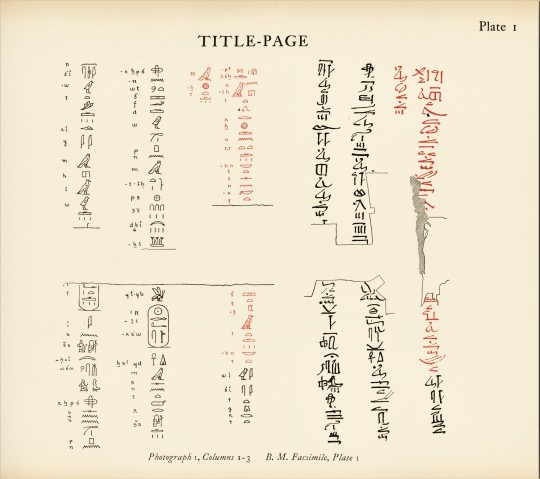
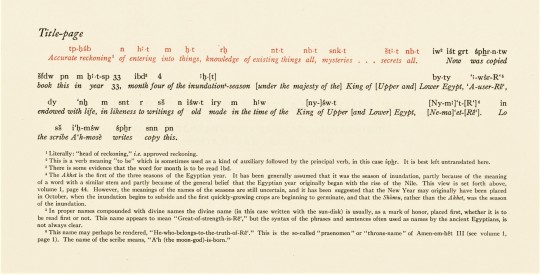



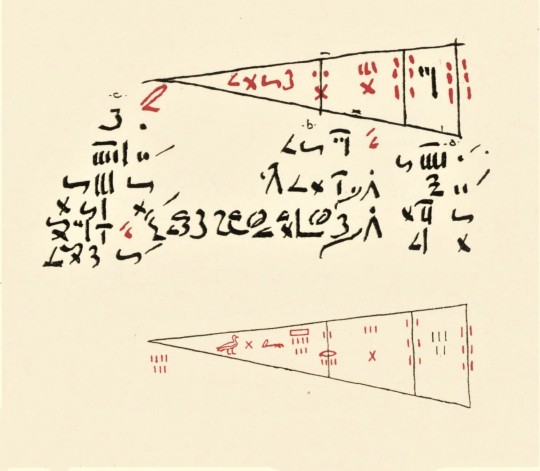



An Egyptian Mathematics Science Saturday
While Archimedes of Syracuse (287-212 BCE) is often considered the first to calculate the value of Pi (π), the Egyptians got pretty darn close a millennium and a half or so earlier, as evidenced by the Rhind Mathematical Papyrus. Copied by the scribe Ahmes sometime around 1650 BCE from an earlier text, the papyrus gives us a remarkable insight not only into Egyptian mathematics but also customs and culture, from taxation and farming practices to the exchange rate between beer and bread. It is named after Scottish antiquarian Alexander Henry Rhind, who acquired the papyrus sometime around 1858. Held by the British Museum since 1865, it is now suspected that the papyrus entered the antiquities market as a result of illegal excavations.
Our facsimile of the papyrus was the result of fifteen years of scholarship by mathematician Arnold Buffum Chace. The first volume was published in Oberlin, Ohio by the Mathematical Association of America in 1927, with the second volume following in 1929. All of the above images are from the second volume, which contains photographs of the papyrus, as well as transcription transliterations and literal translations by Chace. Chace was assisted in his work by mathematician Henry Parker Manning and Egyptologist Ludlow Seguine Bull. Also included in the second volume is a supplement to the “Bibliography of Egyptian Mathematics” from the first volume, both of which were prepared by Raymond Clare Archibald.
The first publication of the Rhind Papyrus was a translation into German in 1877 by August Eisenlohr. The Mathematical Association of America publication was part if a flurry of new scholarship surrounding the papyrus following advancements in scholarly understanding of Egyptian writing. In the preface to our edition, Chace notes the important 1923 translation by Eric Peet published by Liverpool University Press. Chace remarks that “Egyptologists ... will find philological matters fully discussed by Professor Peet,” while he intended for his work to be geared towards both mathematicians and the general public.
Both volumes were originally donated to the Library of the State Teachers College Milwaukee by the Carnegie Corporation of New York with their bookplate.
Check out more Science Saturday posts here.
-Olivia, Special Collections Graduate Intern
#Science Saturday#Rhind Papyrus#Rhind Mathematical Papyrus#Ahmes#Ahmose#Alexander Henry Rhind#Arnold Buffum Chace#Arnold Chace#Mathematical Association of America#Henry Parker Manning#Ludlow Seguine Bull#Raymond Archibald#August Eisenlohr#Eric Peet#Mathematics#Mathematics in Antiquity#Antiquities#Papyrus#olivia
34 notes
·
View notes
Text
youtube
In this talk from the 2022-23 edition of the Herodotus Helpline, Alex Tarbet (Michigan) explores the impact of various Egyptian adventure stories and other tales drawn from oral folklore on Herodotus' Histories. As part of the talk, Alex looks at The Blinding of Pharos, preserved in both Demotic Egyptian (~3rd century BCE) and Herodotus’ Greek (5th century BCE).
Source: the youtube channel of Herodotus Helpline
Alex Tarbet is a PhD candidate in Classics and Sylvia 'Duffy' Engle Graduate Fellow at the University of Michigan (https://lsa.umich.edu/humanities/people/2022-23-fellows/alex-tarbet.html). According to the information given on his dissertation by the University (https://lsa.umich.edu/classics/people/graduate-students/language-and-literature-graduate-students/coleem.html ):
Alex studies humor at the expense of tyrants and authoritarians as it passed among storytellers of Greece and Egypt. His dissertation, Worlds Upside Down: Egyptian Folk Humor and Herodotus, explores comic anecdotes about the pharaohs Egyptians performed for Herodotus as he traveled along the Nile in the 5th century.
Good video, very similar to the text of the same author on Egyptian cats and Herodotus that I have reproduced almost one year ago (https://aboutanancientenquiry.tumblr.com/post/670193035428184064/herodotus-and-the-egyptian-cats ). But I think that Tarbet’s passion for the “decolonization’ of the Classics leads him too far when for instance he says that Aristophanes is a “huge celebrity” just because of an “accident of colonialism”!
Now, more particularly concerning Herodotus, I have the objection that Tarbet approaches the question of the Egyptian sources of Herodotus and of their agendas almost exclusively from the point of view of his specialty, which is humor and power in Egypt and Greece. I think that this is a real aspect of the story about what Herodotus heard from his Egyptian sources, in which there were for sure some tales with a humoristic element in them, but not the whole story. I think also that the question of the relationship of Herodotus with his Egyptian sources and the nature and degree of the historical consiousness and the agendas of the latter deserves a deeper approach and study. Moreover, I don’t think that describing Herodotus as a “tourist” conveys a very accurate picture of the reality: if it is true that Herodotus visited Egypt for a relatively short period of time, it is undeniable that his pursuits in Egypt were scholarly, not those of a modern “tourist” (and the more general ambience in the Egypt of the 440′s BCE, when Herodotus must have visited the country, was not particularly jovial and tourist-friendly, as it is generally accepted that the Persian rule of Egypt had become far more oppressive after the revolt of 460-454 BCE, which ended with the crushing defeat of the revolted Egyptians and of their Greek allies).
Now, the author who contributed the most to the discovery of the similarities about which Tarbet talks between what Herodotus records on the pre-Saite history of Egypt (before 664 BCE) and the Egyptian Demotic tradition is Joachim Friedrich Quack, German Egyptologist, Demotic language specialist, and professor of Egyptology at the University of Heidelberg (see in German J-F. Quack Einführung in die altägyptische Literaturgeschichte III. Die demotische und gräko-ägyptische Literatur, 2, Berlin 2009, and in English Joachim Friedrich Quack- Kim Ryholt Demotic Literary Texts from Tebtunis and Beyond, Museum Tusculanum Press, 2019). So, I think that it is important to see what conclusions drew from these similarities Pr. Quack.
First of all, as I have showed in an older post of mine, Quack believes that the similarities between Herodotus’ Book II and the Demotic Egyptian literature prove that Herodotus did have an important degree of knowledge of the Egyptian tradition, and therefore what he writes about Egypt is not some aggregate of lies or of arbitrary products of his own imagination, as some people foolishly claim on this site (see https://aboutanancientenquiry.tumblr.com/post/701378423007952896/egyptology-professor-j-fr-quack-on-herodotus ,with the further link to the entirety of Quack’s original text in French). As Pr. Quack says ( the translation to English is mine):
“Although it is undeniable that Herodotus is capable of modifying certain details in order to make them agree with his own way of thinking, this can by no means change the overall picture: Herodotus shows such a precise knowledge of the Egyptian traditions and realities that it is difficult to not admit the reality of the visit to Egypt of the “father of history”. The “Liar school” 98 which denies this visit is explicitly refuted. Also the tradition of research which sees above all in the relations of Herodotus with foreign peoples a mirror effect putting into relief their otherness in comparison to the Greeks, without taking enough into account the realities 99, is proved to be inadequate to deal with the complexity of the work of the historian from Halicarnassus.”
Moreover, Quack believes that Herodotus’ account of the pre-Saite history of Egypt is not the product of misunderstanding from Herodotus’ part of jokes of low rank Egyptian priests (or “priests’) or more generally of Herodotus’ confusions, but reflects rather the confusions and distortions in the historical consciousness of the Egyptian priests of his time (see again https://aboutanancientenquiry.tumblr.com/post/701378423007952896/egyptology-professor-j-fr-quack-on-herodotus , with the further link to Quack’s text). As Pr. Quack puts it (the translation from the French original is again mine):
“Herodotus often refers to what he has heard from Egyptian priests 96. The demotic texts that I have presented here originate largely in a priestly milieu, as it is showed clearly enough in the papyri of Tebtynis. This makes also abundantly clear that the traditions on the Egyptian past and the exploits of the heroes, which have often been characterized as “folkloric” 97, have a solid basis in the stories circulating among the priests of Late Egypt. And where Herodotus’ narrative seems to us strange, concerning the anecdotes on the Egyptian kings or their order of succession, it would be appropriate to impute this strangeness less to the errors and misunderstandings of the Greek historian or to the fancies of uncultured guides than to the confusions which had been already produced during the long transmission of the Egyptian culture.”
PS: To my great amusement, I see that Alex Tarbet’s video on the youtube channel of Herodotus Helpline is used by some people on tumblr in order to vindicate the anti-Herodotus campaign of the gang of tumblr egyptologists or, in some cases, “egyptologists” (you know, the “Herodotus is my bitch”, “Fuck Herodotus”, “Fuck Herodotus and fuck yourself”, “most misconceptions about ancient Egypt can be traced back to Herodotus’ Greek ass” etc etc graceful and scholarly ladies, and their sycophants, maids, and ignorant and fanatical fanbase). I think that what I have written above is a sufficient reply to their ridiculous claims. But, just for the sake of completeness, I will return in some days with a more detailed post on Herodotus, the pre-Saite history of Egypt, and his Egyptian sources.
8 notes
·
View notes
Text
The top Egyptologists will act as your stint attendants on the most popular day passages and excursions in Cairo.
2 notes
·
View notes
Text
As I reading "The Snake, The Crocodile and The Dog", another Amelia Peabody mystery, I feel I should point out that there are several people mentioned in the story who were very real and important in the field of archaeology.
Gaston Maspero (M. Maspero)- he was a leading Egyptologist, who specialised in Egyptian language. In November 1880 Maspero went to Egypt as head of an archeological mission sent there by the French government, which ultimately developed into the well-equipped Institut Français D'archéologie Orientale. Upon the death of Egyptologist Auguste Mariette in 1881, M. Maspero took on the role as director-general of excavations and of the antiquities of Egypt. In 1882, he discovered the tomb of Amenemhet I.
Emerson's "rival", Petrie, was actually a very important person in the field of Egyptology. Flinders Petrie was a British Egyptologist and Archaelogist, whose contributions greatly influenced both fields, and their establishment as scientific disciplines. Petrie is best known for creating a system of relative dating using pottery styles called "seration".
Also mentioned, briefly, was the "square-jawed, clean-shaven American named Reisner". They are referring to George Reisner. He was an Egyptologist and Archaeologist as well as the director of the Harvard-Museum of Fine Arts, Boston expedition. His work was extensive and he made contributions to the fields of Egyptology and Archaeology. He dedicated his life to bringing the beauty of Ancient Egypt to life. He kept meticulous records of every object found. His work still lives on throughout the world through his documentation, which has allowed the findings in Egypt to be disseminated throughout the world.
Also mentioned in the book, however briefly, is a chap named Lepsius: “Especially in view of the fact that Lepsius mentions seeing such tombs in 1843.”
Lepsius is Karl Richard Lepsius, a German Egyptologist whose many contributions helped establish the scientific field of Egyptology. Lepsius led the Prussian Expedition to Egypt and Nubia (Syria) between 1842-1845. The main outcome of this expedition was "Denkmäler aus Ägypten und Äthiopien" (a collection of plans, maps, and drawings of Ancient Egyptian tomb and temple walls). This was Lepsius's greatest legacy. He had also been a Professor of Egyptology at Berlin University and a co-director of the Egyptian Museum in Berlin.

#elizabeth peters#amelia peabody#Amelia Peabody Mysteries#historical fiction#books#reading amelia#currently reading#egyptian themed mysteries#egyptologists#archæology#Karl Richard Lepsius#George Reisner#Gaston Maspero#Flinders Petrie#archaeology mysteries#famous Egyptologists#Harvard-MFA#mystery books#Emerson and Peabody#The Snake The Crocodile and The Dog#Barbara Mertz#Egyptology
2 notes
·
View notes
Text
PARIS —
A former director of the Louvre Museum in Paris has been charged with conspiring to hide the origin of archaeological treasures that investigators suspect were smuggled out of Egypt in the chaos of the Arab Spring, a French judicial source said Thursday.
Jean-Luc Martinez was charged Wednesday after being taken in for questioning along with two French specialists in Egyptian art, who were not charged, another source close to the inquiry told AFP.
The Louvre, which is owned by the French state, is the world's most visited museum with around 10 million visitors a year before the COVID-19 pandemic and is home to some of Western civilization's most celebrated cultural heritage.
The museum declined to comment when contacted by AFP.
French investigators opened the case in July 2018, two years after the Louvre's branch in Abu Dhabi bought a rare pink granite stele depicting the pharaoh Tutankhamun and four other historic works for 8 million euros ($8.5 million).
Martinez, who ran the Paris Louvre from 2013-21, is accused of turning a blind eye to fake certificates of origin for the pieces, a fraud thought to involve several other art experts, according to French investigative weekly Canard Enchaine.
He has been charged with complicity in fraud and "concealing the origin of criminally obtained works by false endorsement," according to the judicial source.
Martinez is currently the French foreign ministry's ambassador in charge of international cooperation on cultural heritage, which focuses in particular on fighting art trafficking.
"Jean-Luc Martinez contests in the strongest way his indictment in this case," his lawyers told AFP in a statement.
Arab Spring looting
"For now, he will reserve his declarations for the judiciary, and has no doubt that his good faith will be established," they said.
French investigators suspect that hundreds of artifacts were pillaged from Egypt and other Middle Eastern countries during protests in the early 2010s that became known as the Arab Spring. They suspect the artifacts were then sold to galleries and museums that did not ask too many questions about previous ownership.
Martinez's indictment comes after the German-Lebanese gallery owner who brokered the sale, Robin Dib, was arrested in Hamburg in March and extradited to Paris for questioning.
Marc Gabolde, a French Egyptologist, was quoted by Canard Enchaine as saying that he informed Louvre officials about suspicions related to the Tutankhamun stele but received no response.
The opening of the inquiry in 2018 roiled the Paris art market, a major hub for antiquities from Middle Eastern civilizations.
In June 2020, prominent Paris archaeology expert Christophe Kunicki and dealer Richard Semper were charged with fraud for false certification of looted works from several countries during the Arab Spring.
They also had a role in certifying another prized Egyptian work, the gilded sarcophagus of the priest Nedjemankh that was purchased by the Metropolitan Museum of Art in New York in 2017.
Gabolde said an Egyptian art dealer, Habib Tawadros, was also involved in both suspect deals.
After New York prosecutors determined that the sarcophagus had been stolen during the revolts against Egyptian president Hosni Mubarak in 2011, the Met said it had been a victim of false statements and fake documentation, and returned the coffin to Egypt.
7 notes
·
View notes
Text
Query. Why are the first two introduced characters in "The Strongest Sage with the Weakest Crest" named after an early Prussian egyptologist and the leading German egyptology museum? Asking for me
#I will not be sticking around for long enough with this tv show to find out for myself#(I am checking out the first episodes of all my brother's fav animes to see what works for me)#and anyway I suspect the answer is 'the words sounded good'#but listen. I was amused by Lepsius. I would have ignored Hildesheim. I could not ignore both in the same scene#it's not a BAD thing I'm just confused#anyway. is there an answer#strongest sage#shikkakumon#chaos rambles
1 note
·
View note
Text
On this day in Wikipedia: Friday, 16th February
Welcome, nuqneH, merħba, selamat datang 🤗
What does @Wikipedia say about 16th February through the years 🏛️📜🗓️?

16th February 2021 🗓️ : Event - Kherrata
Five thousand people gathered in the town of Kherrata, Bejaia Province to mark the two year anniversary of the Hirak protest movement. Demonstrations had been suspended because of the COVID-19 pandemic in Algeria.
"Kherrata is a commune in northern Algeria in the Béjaïa Province...."

Image licensed under CC BY-SA 3.0? by Yelles
16th February 2019 🗓️ : Death - Bruno Ganz
Bruno Ganz, Swiss actor (b. 1941)
"Bruno Ganz (German: [ˈbruːno ˈɡant͡s] ; 22 March 1941 – 16 February 2019) was a Swiss actor whose career in German stage, television and film productions spanned nearly 60 years. He was known for his collaborations with the directors Werner Herzog, Éric Rohmer, Francis Ford Coppola, and Wim Wenders,..."

Image licensed under CC BY-SA 3.0? by Loui der Colli
16th February 2014 🗓️ : Death - Ken Farragut
Ken Farragut, American football player (b. 1928)
"Kenneth David Farragut, Jr. (December 23, 1928 – February 16, 2014) was an American football center. He played professionally in the National Football League (NFL) for the Philadelphia Eagles...."

Image by Bowman
16th February 1974 🗓️ : Birth - José Dominguez
José Dominguez, Portuguese footballer and manager
"José Manuel Martins Dominguez (born 16 February 1974) is a Portuguese former footballer who played as a winger, currently assistant manager of Cypriot First Division club APOEL FC. A diminutive player with above-average technical skills and speed, he started playing professional football not in his..."
16th February 1923 🗓️ : Event - Howard Carter
Howard Carter unseals the burial chamber of Pharaoh Tutankhamun.
"Howard Carter (9 May 1874 – 2 March 1939) was a British archaeologist and Egyptologist who discovered the intact tomb of the 18th Dynasty Pharaoh Tutankhamun in November 1922, the best-preserved pharaonic tomb ever found in the Valley of the Kings...."

Image by Chicago Daily News, Inc., photographer
16th February 1824 🗓️ : Birth - Peter Kosler
Peter Kosler, Slovenian lawyer, geographer, and cartographer (d. 1879)
"Peter Kosler or Kozler (16 February 1824 – 16 April 1879) was an Austrian-Slovene lawyer, geographer, cartographer, activist, and businessman. He was of ethnic German origin, but also identified with Slovene culture and advocated the peaceful coexistence of the Slovene and German cultures in..."

Image by Ludwig Angerer
16th February 🗓️ : Holiday - Elizabeth Peratrovich Day (Alaska)
"Elizabeth Peratrovich (née Elizabeth Jean Wanamaker; Tlingit: Ḵaax̲gal.aat [qʰaχ.ɡʌɬ.ʔatʰ]; July 4, 1911 – December 1, 1958) was an American civil rights activist, Grand President of the Alaska Native Sisterhood, and member of the Tlingit nation who worked for equality on behalf of Alaska Natives...."
0 notes
Text
“The real story of the scramble for Africa is presented…as having started some time around 1830 AD when France invaded Cueta, the most northern part of Morocco closest to what will be today the Rock of Gibraltar. And from 1830 that scramble went on until 1864 and then again started in 1884 at which time the Berlin Conference was called by Otto Von Bismarck and Kaiser Wilhelm.
But that kind of analysis will be totally in error…
The scramble for Africa took place before there was the first European power in history. I’m talking about before there was Greece. The scramble for Africa took place before there was a book in the Bible called Genesis… The scramble for Africa took place when the first non-African people invaded Africa for the purpose of taking the African land, that takes us up to 1675 BCE when the Hykos, the people called the Shepherd Kings came from around the Oxus River in Asia and invaded Lower Egypt. The Africans were already in their Thirteenth dynastic.”
Yosef Ben-Jochannan, also known as Dr. Ben, was an African-American scholar, historian and lecturer, respected for his meticulous research into the roots of African history. As an African-centered historian, Dr. Ben’s work focused mainly on the Black presence in ancient Egypt. He contends in his writings that the pharaohs came out of the heart of Africa and that the original Jews were from Ethiopia and were Africans, and the whyte Jews adopted the faith and customs later. He has been accused of distorting history by Eurocentric historians and, since his work contradicts their prevailing view of Egyptian and African history, it is, therefore, deem controversial.
Dr. Ben reported that he was born in Ethiopia to a Puerto Rican mother, Julia Matta and an Ethiopian father, Kriston Ben-Jochannan. He was named after his grandfather Jochannan. In fact, his name is Hebrew and means Joseph the son of Jonathan. Shortly after his birth, the family moved to St. Croix, part of the United States Virgin Islands, where he grew up as an only child. Dr. Ben travelled extensively with his parents through South America and was educated in Puerto Rico, Brazil, Cuba, and Spain, with the idea of becoming a civil engineer.
Dr. Ben immigrated to the United States in 1945 and made New York City his home base until early 1988 when he took up residence in Cairo/Giza, Egypt. He worked as a draftsman and continued his studies. He conducted research in Africa, mainly Egypt, Sudan and Ethiopia. He was well versed in Hebrew, Spanish, Portuguese, Arabic, Greek and had a reading knowledge of Italian and classical German. Dr. Ben began his educational teaching in Harlem in 1967 at HARYOU-ACT. He worked as an adjunct professor (1973-1987) at Cornell University in the Africana Studies and Research Center, then directed by James Turner. He also taught at other institutions, including Malcom-King College in Harlem and Rutgers University. In 1977 he accepted an honorary faculty position with the Israelite Rabbinical Academy at Beth Shalom Hebrew Congregation in Brooklyn.
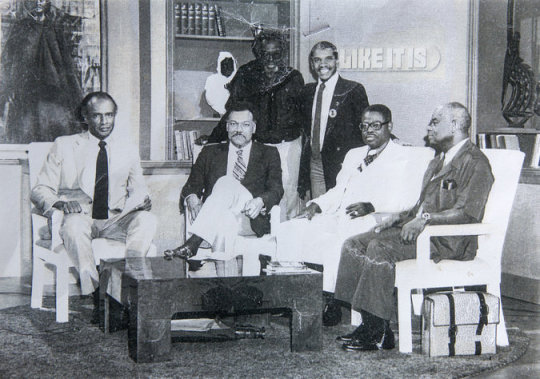
Dr. Ben appeared several times on Gil Noble’s WABC-TV weekly public affairs series Like It Is.
Dr. Ben was a prolific author whose writing focused primarily on ancient Nile Valley civilizations and their influence on Western cultures. According to Nick Chiles writing for Atlanta Black Star, “One of [Dr. Ben’s] many specialties was the ancient civilization of Kemet in Egypt. He was one of the first true Egyptologists, before that title had even come into vogue. Dr. Ben was always a controversial figure because he had no interest in trying to placate European scholars or writers who were threatened by his claims about Africa, Europe and the Middle East.”
In 2002, Ben-Jochannan donated his personal library of more than 35,000 volumes, manuscripts and ancient scrolls to the Nation of Islam.
Dr. Yosef Ben-Jochannan died in Harlem, New York on March 19, 2015 at the age of 96 at the Bay Park Nursing Home in the Bronx. He had been married three times and had a total of 13 children.
“Of all our greats, Dr. Ben physically took tens of thousands of scholars, activists, students and associations to the Nile Valley to make the pages of his book more authentic,” said his colleague, Reggie Mabry. “We saw our own experiences of what he wrote… For that the Black world is indebted to this Black man of the Nile and his family.”
Visit Black Classic Press for his books:
Source:
http://www.raceandhistory.com/Historians/ben_jochannan.htm
https://en.wikipedia.org/wiki/Yosef_Ben-Jochannanhttp://www.blackjews.org/dr-yosef-ben-jochannan-black-jewish-historian/
http://atlantablackstar.com/2015-03-20-abs-celebrates-the-life-of-a-great-man-and-legendary-scholar-dr-yosef-ben-jochannan-dec-31-1918-march-19-2015/
http://www.blackpast.org/aah-ben-jochannan-yosef-1918
0 notes
Photo


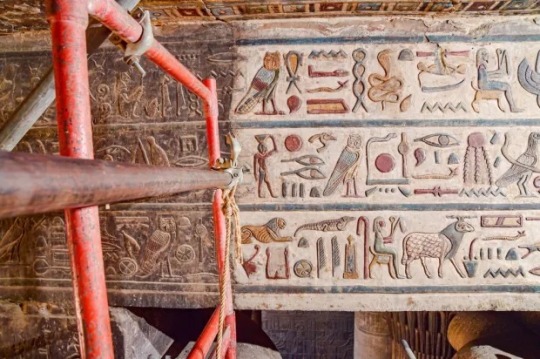




Incredible Colorful Ceiling Frescoes Discovered In Ancient Egyptian Temple
Two millennia's worth of soot and dirt covered the ceiling frescoes in the temple of Khnum in the Egyptian city of Esna, protecting the colors underneath. Now, painstaking restoration work from archeologists has brought these incredible pieces of art back to life.
The frescoes have 46 images of vultures, representing, in turn, the Upper-Egyptian vulture goddess Nekhbet and the Lower-Egyptian serpent goddess Wadjet, who is also depicted as a vulture with open wings, although keeping the head of a cobra and the crown of Lower Egypt. Nekhbet is wearing the Upper Egypt crown.
The restoration was conducted by the Institute for Ancient Near Eastern Studies at the University of Tübingen and the Egyptian Ministry of Tourism and Antiquities. They have been working since 2018 to bring the colors of the frescoes back into view.
“Temples and ancient depictions of the gods were often painted in brilliant colors, but these have usually faded or even disappeared totally as a result of external influences,” Professor Christian Leitz from the University of Tübingen, said in a statement.
The temple was dedicated to one of the earliest Egyptian deities, Khnum the ram-headed god who was seen as the god of the source of the Nile. At Esna, Khnum and his consort Neith are treated as the creator deities.
Construction of the religious building had begun during Ptolemaic time but most of the remaining parts are from the Roman era, probably around the time of Emperor Claudius (41-54 CE). The temple began to attract the interest of archeologists in Napoleonic times, but it was in the latter part of the last century that a more detailed study of it began in earnest.
“From the 1950s, the French Egyptologist Serge Sauneron systematically documented the Temple of Khnum at Esna and the paintings that were visible at that time,” said Tübingen scientist Dr. Daniel von Recklinghausen, “The temple’s complete range of images is unique in its wealth of figures and the state of preservation of the colors.”
“For the first time we can see all the decorative elements in relation to one another,” said Leitz. “This was impossible simply with Sauneron’s publication.”
The whole restoration was funded by the American Research Center in Egypt, the Ancient Egypt Foundation, and the Gerda Henkel Foundation. The team is now planning to translate all of the Esna inscriptions, as well as study the connection between all the images and writing in the temple. This upcoming work has been funded by the German research foundation.
#Incredible Colorful Ceiling Frescoes Discovered In Ancient Egyptian Temple#the temple of Khnum in Esna Egypt#archeology#archeol#ancient frescoes#ancient art#egyptian art#art#artist#art work#art news#history#history news#ancient history#ancient culture#ancient civilizations#ancient egypt#egyptian history#egyptian gods
126 notes
·
View notes
Note
I was wondering if I could ask for some help regarding hieroglyphs and pronouncing them (I know there is no official way to pronounce them but I mean the standard that Egyptologists use). I just am getting confused about the symbols used when spelling them out in the Latin alphabet. It;s stuff like "sḏm-ꜥš m st mꜣꜥt" which makes me wonder what those are supposed to be in a phonetic sense.
Are you using a book to teach you, or are you doing this by yourself? Generally, books will have a whole section at the start when they teach you one consonant signs that will tell you how to pronounce the transliteration (which is the 'Latin Alphabet stuff') of the signs.
Any sign that doesn't have a diacritic (the symbols above or below a letter) is pronounced like the standard way you'd pronounce that letter. An s is an s, and a b is a b, and so on and so forth.
When it comes to the transliteration letters with diacritics:
ꜣ is A (if you're not using a transliteration script) and is voiced as a glottal stop. This is like voicing Kitten as Kitt'n, or bottle and 'bo''le' (boh-oll).
ꜥ is a and is voiced as ah (like when a doctor asks you to open wide and say ahhhh) (a in non translit script)
ḥ is just h, but said emphatically (H in non translit script)
ḫ is a softer h, so more like the h in loch (x in non translit)
ḫ is a harder h, so like the h on the end of German ich (X in non translit)
š is sh like ship/shingle/shout (S in non translit)
ḳ is a q/k noise made at the back of the throat. It usually comes out as a q sound (q in non translit)
ṯ is a tch noise like t in tune (T in non translit)
ḏ is dj sound like French 'mon dieu' or the j in joke (D in non translit)
So your sentence sḏm-ꜥš m st mꜣꜥt is sDm-aS m st mAa.t which is sedjem-ash em set maat (Servant in the Place of Truth)
160 notes
·
View notes
Text
Scientists Discover New Rooms Inside Ancient Egyptian Pyramid
Sci Tech Daily
By UNIVERSITY OF WÜRZBURG SEPTEMBER 29, 2023
A team of Egyptian and German specialists, led by Egyptologist Dr. Mohamed Ismail Khaled from the Department of Egyptology at Julius-Maximilians-Universität of Würzburg (JMU), has made an important finding inside Sahura’s Pyramid.
The team uncovered several previously undocumented storage rooms during their exploration. This new…

View On WordPress
0 notes
Text
Unlocking the Zodiac Sign and Personalities of Those Born on May 7
They are individuals with a ton of soul and, when they lay out their goals, they endeavor to accomplish them with incredible steadiness and resolution. In any case, these characteristics don't work out easily for them, yet should be incited, that something moves them aggravated aspiration. That is on the grounds that they are by and large very sluggish individuals. Simultaneously, their psyches are sharp and dynamic, and they are not ailing in unique thoughts. Their spirits are frequently loaded up with imaginative motivation. They are exceptionally keen on workmanship and express very much a feeling of variety and melodic ear. They have a seriously critical social impact, with many undertakings to finish throughout everyday life. Be that as it may, they can't as expected center in a chaotic and fretful climate, so they need an amicable and serene climate. They have numerous connections and show solid exotic nature and cherishing sentiments. They partake in the organization of the other gender. They show restraint, continuing on, and fit for actual work. Your personality and state of mind go through changes. Now and again they are quiet, different times they talk. They are by and large very impassive and appreciate solace and extravagance. On the off chance that they are not disturbed they show accommodation, watchfulness, strength and constancy. They are effortlessly aggravated, however this is difficult to see since outrage is secured inside. Regardless, your current circumstance ought to persuade your desire; if not, they might show disappointment, propensities to despairing and hardheadedness. They are not liberated from the sensation of jealousy. They likewise express a specific sort of unyieldingness, adhering rigorously to subtleties and the conventional importance of words. They can't stand when somebody challenges them.
Unlocking the Zodiac Sign and Personalities of Those Born on May 7
Assuming your birthday is on May 7, your zodiac sign is Taurus
May 7 - character and character
character: wise, decent, insightful, self centered, tricky, vindictive; calling: entertainer/entertainer, landscaper, review or; varieties: beige, dark, yellow; stone: red emerald; creature: hummingbird; plant: mint plant; fortunate numbers: 19,24,38,42,50,59 very fortunate number: 28
Occasions and observances - May 7
Cocentaina (Valencian People group): festivity? Starting around 1600? of the announcement of Holy person Hippolytus of Rome (saint).
May 7 Big name Birthday. Who was conceived that very day as you?
1901: Gary Cooper, American entertainer (d. 1961). 1901: Marcel Poot, Belgian artist (d. 1988). 1902: Jean-Philippe Lauer, Egyptologist and French modeler (d. 2001). 1905: Honey bee Thin, American blues performer (d. 1968). 1909: Edwin Herbert Land, innovator and American physicist (d. 1991). 1911: Ishiro Honda, Japanese movie producer (d. 1993). 1912: დ?ngel Marდa de Lera, Spanish author (d. 1984). 1917: David Tomlinson, English entertainer (d. 2000). 1918: Argeliers Leდ³n, Cuban author, musicologist and ethnologist (d. 1991). 1919: Eva Evita Duarte de Perდ³n, Argentine entertainer and legislator, spouse of President Juan Domingo Perდ³n (d. 1952). 1919: Joe Mitty, English money manager (d. 2007). 1921: Simდ³n Bonifacio Rodrდguez y Rodrდguez, Spanish judge (f. 2012). 1922: Darren McGavin, American entertainer (d. 2006). 1922: Tony Leblanc, Spanish entertainer (d. 2012). 1923: Anne Baxter, American entertainer (d. 1985). 1927: Elisabeth Sდ¶derstrდ¶m, Swedish soprano (d. 2009). 1927: Ruth Prawer Jhabvala, German-conceived American writer (d. 2013). 1929: Osvaldo Dragდºn, Argentine writer (d. 1999). 1931: Teresa Brewer, American vocalist (d. 2007). 1931: Ricardo Legorreta Vilchis, Mexican modeler (d. 2011). 1931: Ingvar Wixell, Swedish baritone (d. 2011). 1931: Quality Wolfe, American author. 1932: Pete Domenici, American lawmaker. 1933: Johnny Unitas, American football player (d. 2002). 1937: Domitila Barrios, Bolivian work lobbyist and women's activist (f. 2012). 1939: Sidney Altman, Canadian organic chemist, 1989 Nobel Prize champ for science. 1939: Ruggero Deodato, Italian movie chief, entertainer and screenwriter. 1939: Ruud Loafers, Dutch government official. 1940: Angela Carter, English writer and author (d. 1992). 1944: Rafael de Diego, Spanish footballer (d. 1982). 1944: Eva Norvind, Mexican entertainer (f. 2006). 1946: Thelma Houston, American artist. 1947: Guillermo Carnero, Spanish writer and writer, financial expert and philologist. 1948: Lluდs Llach, Spanish artist lyricist. 1951: Bernat Soria, Spanish researcher and government official. 1952: Josep-Lluდs Carod-Rovira, Spanish government official. 1956: Jan Peter Balkenende, Dutch government official and State head. 1957: Dave Taylor, American grappler. 1960: Kim Monitoring, Spanish entertainer of American beginning. 1960: Almudena Grandes, Spanish essayist. 1961: Phil Campbell, English guitarist, of the band Motდ¶rhead. 1962: Ari Telch, Mexican entertainer. 1963: Johnny Lee Middleton, American bassist, of the groups Savatage and Trans-Siberian Symphony. 1963: Sergio Battistini, previous Italian footballer. 1964: Denis Mandarino, Brazilian author, craftsman, essayist and geometrician. 1965: Owen Hart, Canadian expert grappler (d. 1999). 1968: Traci Rulers, American entertainer. 1969: Josდ© Manuel Moreno Perinდ¡n, Spanish cyclist. 1970: Gregorio Pernდa, Colombian TV entertainer. 1971: Sharp vision Cherry, Swedish artist and performer. 1971: Horgh (Reidar Horghagen), Norwegian drummer, of the groups Interminable and Lip service. 1971: Thomas Piketty, French business analyst. 1971: Ivan Sergei, American entertainer. 1972: Peter Dubovsky, Slovak footballer. 1973: Paolo Savoldelli, Italian cyclist. 1974: Breckin Meyer, American entertainer. 1975: Fernando Lima, Argentine artist. 1976: Thomas Biagi, Italian motorsport driver. 1978: Stian Arnesen, Norwegian artist and performer. 1978: Shawn Marion, American ball player. 1979: Mohand al-Shehri, Saudi fear based oppressor who took part in 9/11 (d. 2001). 1982: Iban Garate, Spanish entertainer. 1983: Makano (Hernდ¡n Enrique Jimდ©nez), Panamanian artist. 1984: Kevin Owens, Canadian grappler. 1985: J Balvin, Colombian artist musician. 1986: Matt Helders, English drummer, of the band Icy Monkeys. 1987: Pierre Ducasse, French footballer. 1987: Serge Gakpდ©, French footballer. 1987: Jდ©rდ©my Menez, French footballer. 1987: Yaroslav Koroliov, Russian ball player. 1987: Asami Konno, Japanese artist. 1988: Brandon Jones, American entertainer, maker and artist. 1988: Takayuki Morimoto, Japanese footballer. 1989: Raina (Goodness Hye Rin), Korean artist, has a place with the gathering After School. 1992: Alexander Ludwig, Canadian entertainer. 1993: Tyler Johnson, American ball player. 1997: Youri Tielemans, Belgian footballer. 1997: Daria Kasatkina, Russian tennis player.
0 notes